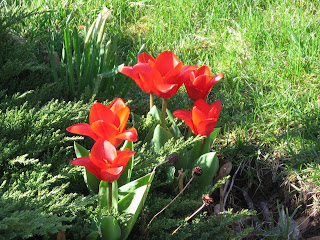
Drought Tolerant Plants:
Summers ain’t what they used to be in Southern Ontario! Heat and humidity would set in in early July and stay until mid-September. Rainy days were nicely scattered throughout the spring and summer seasons and everything seemed so predictable!
Not so lately! I remember that in the summer of 2000 or 2001, it rained June 30th and then not one drop more until late September!! Yikes! Lawns, flowers, trees and shrubs dried up and withered away. It was pathetic to look at. Water bans were imposed, so even the lucky few with underground sprinkler systems, were not allowed to use them. Most summers since then have had real elements of drought as well.
So, gardeners being the resourceful souls that we are, began to research plants that could withstand drought.
Here are some excellent examples of plants that do well in hot, dry conditions:
Perennials:Alchemilla mollis – Lady’s Mantle
Aquilegia species – Columbines
Summers ain’t what they used to be in Southern Ontario! Heat and humidity would set in in early July and stay until mid-September. Rainy days were nicely scattered throughout the spring and summer seasons and everything seemed so predictable!
Not so lately! I remember that in the summer of 2000 or 2001, it rained June 30th and then not one drop more until late September!! Yikes! Lawns, flowers, trees and shrubs dried up and withered away. It was pathetic to look at. Water bans were imposed, so even the lucky few with underground sprinkler systems, were not allowed to use them. Most summers since then have had real elements of drought as well.
So, gardeners being the resourceful souls that we are, began to research plants that could withstand drought.
Here are some excellent examples of plants that do well in hot, dry conditions:
Perennials:Alchemilla mollis – Lady’s Mantle
Aquilegia species – Columbines
 Bergenia crassifolia
Bergenia crassifoliaCampanula species
Coreopsis species
Echinops ritro – Globe Thistle
Eryngium species – Sea Holly
Gaillardia species – Blanket Flower
Galium odoratum – Sweet Woodruff

Hemerocallis hybrids – Daylilies
 Paeonia species – Peonies
Paeonia species – PeoniesPenstemon species
 Perovskia atriplicifolia – Russian Sage
Perovskia atriplicifolia – Russian SageRudbeckia species – Black-eyed Susan
Sedum species
Veronica species – Speedwell
Vinca minor – Periwinkle
Bulbs:
Allium species
Crocus
Chionodoxa species – Glory in the Snow
Galanthus species – Snowdrops
Lilium species – Lilies
Narcissus species – Daffodils
Tulipa species – Tulips
Annuals:Brachycome iberidifolia – Swan River Daisy
Centaura species – Bachelor’s Buttons
 Cleome spinosa – Spider Flower
Cleome spinosa – Spider FlowerCosmos species
 Petunia species
Petunia speciesTargetes species – Marigolds
Verbena species
Roses and Shrubs:
Amelanchier species – Serviceberry
Cotinus coggygria – Smoke Bush
Cotoneaster species
Euonymus species
Forsythia
Kerria japonica
Philadelphus species – Mock Orange
Prunus species
Rosa species - Old garden types – Rosa x alba, Rosa Gallica
 Rugosa roses
Rugosa rosesExplorer roses ‘John Cabot’, John Davis’, William Baffin’
Spirea species
Syringa species – Lilac
Viburnum






















 My 10 Favourite………………………………..SHRUBS
My 10 Favourite………………………………..SHRUBS






















